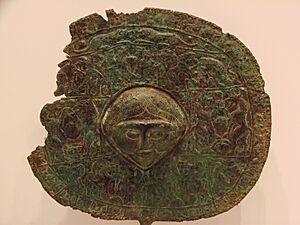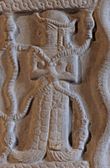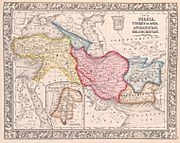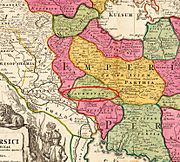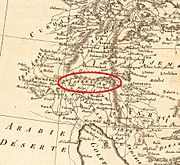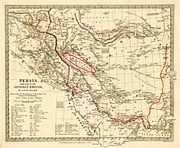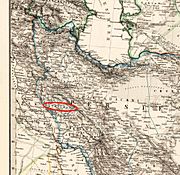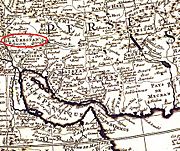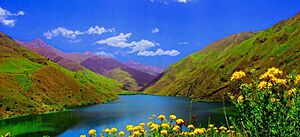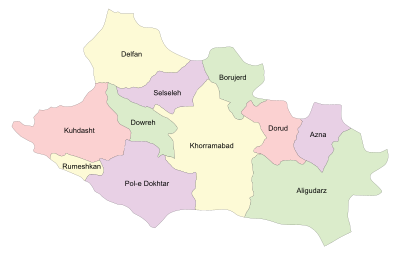Lorestan province facts for kids
Quick facts for kids
Lorestan province
|
|
|---|---|
| Persian: استان لرستان | |

Location of Lorestan province in Iran
|
|
| Country | Iran |
| Region | Region 4 |
| Capital | Khorramabad |
| Counties | 11 |
| Area | |
| • Total | 28,294 km2 (10,924 sq mi) |
| Population | |
| • Total | 1,760,649 |
| • Density | 62.2269/km2 (161.1670/sq mi) |
| Demonym(s) | لرستانی (Lorestani) |
| Time zone | UTC+03:30 (IRST) |
| Main language(s) | Luri, Laki (Kurdish) |
| HDI (2017) | 0.779 high · 19th |
Lorestan Province (also called Luristan or Lurestan, Persian: استان لرستان) is one of Iran's 31 provinces. It is located in the western part of the country, nestled within the Zagros Mountains. The province covers an area of about 28,392 square kilometers.
Its capital city is Khorramabad. In 2016, Lorestan Province had a population of 1,760,649 people. In 2014, it became part of Region 4 of Iran.
Contents
What's in a Name?
The name Lorestan means "land of the Lurs." The Lurs are a group of people who have lived in this region for a very long time.
A Look Back: Lorestan's History
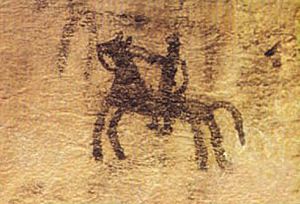
The history of Lorestan is connected to the story of the entire Ancient Near East. Around 3,000 to 4,000 BC, different tribes moved into the mountainous Zagros area and settled there.
One ancient group, the Kassites, came from Lorestan. They spoke a unique language. The Kassites later ruled Babylonia from about 1531 BC to 1155 BC.
Later, in the 2nd millennium BC, parts of Lorestan were settled by the Medes, an Iranian group. The Medes blended with the local people, like the Kassites. By the time the Persians took over in the 1st millennium BC, the region was part of their vast empire. Recently, in 2017, archaeologists found Achaemenid-era items in Lorestan for the first time.
The Famous Luristan Bronze
You might have heard of "Luristan bronze" artworks. These are small bronze objects, often showing animals, that became known to the world in the late 1920s. They are found in museums globally and are admired for their strong and lively style.
While many of these bronzes are from around 1000 to 650 BC, the tradition of making bronze in this area actually started much earlier, around the mid-3rd millennium BC. These older bronze items were made during the Elam period.
Lorestan was successfully part of the Achaemenid, Parthian, and Sasanian empires. Even during invasions by the Arabs, Seljuks, and Mongols, some parts of the region managed to remain independent.
The Qajar Era (1794-1925)
During the Qajar dynasty, leaders like Agha Mohammad Khan Qajar used a "divide and rule" strategy in Lorestan. This meant they tried to make different tribes fight each other. They also appointed governors who were not from Lorestan.
These governors often did not have enough soldiers to keep order or collect taxes. This led to many problems in Lorestan, including:
- Loss of land.
- Less trade and money.
- Political problems.
- Fewer settled communities.
- More people becoming nomadic herders.
Because the Qajars couldn't keep law and order, tribes became stronger and more independent. People who lived in villages found it hard to protect their homes and farms. Many had to either join the nomadic tribes or leave their villages. For example, the Baharvand tribe took over the Khorramabad plains.
When Cecil J. Edmonds visited in 1917, he noted that Khorramabad was the only city, and many villages were ruined. However, in 1836, Rawlinson described the area as "richly cultivated" with "villages and gardens." This shows how much the region changed under Qajar rule.
The Pahlavi Era (1920s-1979)
Bringing Lorestan Under State Control
When Reza Shah started Pahlavi Iran in the 1920s, he wanted to change how the government interacted with local people. This led to a conflict in 1922, which resulted in the government taking control of Lorestan.
Reza Shah believed that the nomadic way of life was an obstacle to modern progress. Taking control of Lorestan was important for him for economic, political, and military reasons. It also helped the state expand its power to other regions like Khuzestan.
The Laki-speaking Beiranvand tribe was particularly challenging for the government. They had confrontations with the Pahlavi forces in 1922. Other tribes did not join the fight due to their own disagreements.
In December 1923, a small army from the Shah moved towards Khorramabad. The Beiranvand tribe defeated the first group of soldiers. However, a second group managed to reach Khorramabad and were welcomed by the local people. The new government then appointed local leaders to official positions.
Despite efforts to avoid conflict, fighting continued, and some tribal leaders were executed. This led to more rebellions from the Beiranvand and other tribes like the Kurdish Chegini and the Romani. These tribes were successful in their early fights against the army.
In May 1924, several tribes attacked Khorramabad together. They pushed the army into the city's fortresses and took their weapons. The tribes then surrounded the city for 38 days. This forced the army general to consider retreating. However, a leader from the Sagvand tribe convinced him to stay, saying the tribes would run out of supplies. The people of Khorramabad also supported the army during this time.
By June 1924, more soldiers arrived. Eventually, some tribes started to leave the alliance due to disagreements. This weakened the tribal forces, allowing the Shah's army to gain control. The conquest of Lorestan was helped by an alliance between the Shah and some loyal tribes. Reza Shah visited Lorestan in the summer of 1924.
Historical Maps
Lorestan's Geography
Lorestan is mostly a mountainous region. It has many mountain ranges that are part of the larger Zagros Mountains. These ranges stretch from northwest to southeast. Some peaks are so high that they are almost always covered in snow, reaching over 4,000 meters (about 13,000 feet).
These mountains are the source of many important rivers in Iran, such as the Zayanderud, Jarahi, Karun, Diz, Abi, and Karkheh. Between the high mountains, you can find many fertile plains and low, well-watered areas.
The highest point in the province is the Oshtorankuh peak, which is 4,050 meters (13,287 feet) tall. The lowest areas are in the south, about 500 meters (1,640 feet) above sea level. The mountain slopes are covered with Oak forests, along with elm, maple, walnut, and almond trees.
Western Lorestan has many fertile valleys running through the high Zagros mountains. The Pusht-i Kuh region is in the western foothills of the Kabir Kuh range. The Pish-i Kuh region is to the east of Kabir Kuh. People have lived in this area since the mid-3rd millennium BC, during the Bronze Age.
Lorestan's Climate
Lorestan's climate changes depending on where you are:
- Mountainous regions (like Borujerd, Dorud, Azna, Nurabad, and Aleshtar) have cold winters and mild summers.
- Central region (where Khorramabad is located) has spring starting in mid-February and lasting until mid-May.
- Southern areas (like Pol-e-Dokhtar and Papi) are influenced by warm air from Khuzestan. They have hot summers and fairly mild winters.
How Lorestan is Divided
| Administrative Divisions | 2006 | 2011 | 2016 |
|---|---|---|---|
| Aligudarz County | 134,802 | 140,275 | 137,534 |
| Azna County | 70,462 | 71,586 | 74,936 |
| Borujerd County | 320,547 | 337,631 | 326,452 |
| Delfan County | 137,385 | 144,161 | 143,973 |
| Dorud County | 159,026 | 162,800 | 174,508 |
| Dowreh County1 | — | 43,221 | 41,756 |
| Khorramabad County | 509,251 | 487,167 | 506,471 |
| Kuhdasht County | 209,821 | 218,921 | 166,658 |
| Pol-e Dokhtar County | 74,537 | 75,327 | 73,744 |
| Rumeshkan County2 | — | — | 39,058 |
| Selseleh County | 73,819 | 73,154 | 75,559 |
| Total | 1,689,650 | 1,754,243 | 1,760,649 |
| 1Separated from Khorramabad County 2Separated from Kuhdasht County |
|||
Cities of Lorestan
In 2016, over 64% of Lorestan's population lived in cities. Here are some of the main cities and their populations:
- Khorramabad: 373,416 people (the capital and largest city)
- Borujerd: 234,997 people
- Dorud: 121,638 people
- Aligudarz: 89,268 people
- Kuhdasht: 89,091 people
- Nurabad: 65,547 people
- Azna: 47,489 people
- Aleshtar: 33,558 people
- Pol-e Dokhtar: 26,352 people
People of Lorestan
The Lurs
Lorestan Province is a main home for the Lur people. The Northern Luri language is the most common language spoken here. This language is also spoken in parts of southern Ilam and Khuzestan provinces.
Lurs make up most of the population in:
- Khorramabad (the capital and largest city)
- Borujerd (the second largest city)
- Dorud (the third largest city)
Khorramabad is also the largest city in Iran and the world where Luri is the main language.
The Kurds
The northern part of Lorestan is home to Kurds from the Lak tribe. In 1980, it was estimated that Laks made up over 65% of the province's population. Lak people live in the Delfan, Dowreh, and Selseleh counties. These areas have various Lak subtribes, including the Chegini, Itivand Kakavand, Nurali, and Papi. The Hasanvand tribe also lives in the Oshtorinan District of Borujerd County.
Some counties like Aligudarz County, Azna County, Kuhdasht County, Khorramabad County, and Pol-e Dokhtar County have a mix of both Kurdish and Luri tribes.
Famous People from Lorestan
- Hossein Borujerdi: A respected Iranian religious leader.
- Shahmirza Moradi: A talented musician.
- Nasrollah Kasraian: A well-known photographer.
- Abdolhossein Zarrinkoob: A famous writer, historian, and critic.
- Sayyed Jafar Shahidi: Another notable writer, historian, and critic.
- Parviz Shahbazi: A writer and filmmaker.
- Loris Tjeknavorian: An Armenian-Iranian composer and conductor.
- Mehdi Karroubi: A politician.
- Qadam Kheyr: A local heroine.
- Narges Rashidi: An actress.
- Seyyed Ahmad Reza Shahrokhi: A representative of Iran's Supreme Leader.
Images for kids
See also
 In Spanish: Provincia de Lorestán para niños
In Spanish: Provincia de Lorestán para niños
- Chehel Minbari
- Luristan bronze
- 2006 Borujerd earthquake
- Luti people


